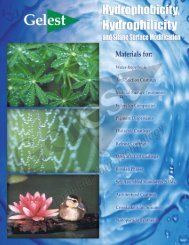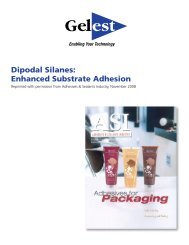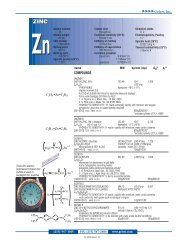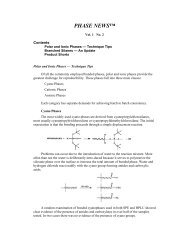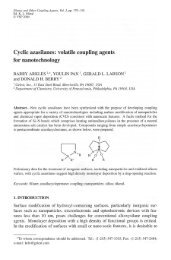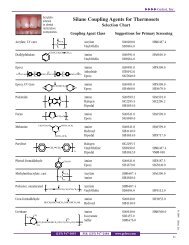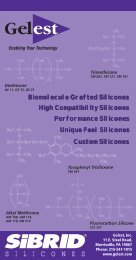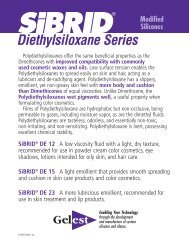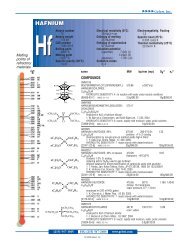Gelest Silicone Fluids - Gelest Inc.
Gelest Silicone Fluids - Gelest Inc.
Gelest Silicone Fluids - Gelest Inc.
You also want an ePaper? Increase the reach of your titles
YUMPU automatically turns print PDFs into web optimized ePapers that Google loves.
▲<br />
▲<br />
▲<br />
▲<br />
<strong>Gelest</strong>, <strong>Inc</strong>.<br />
Appendix 2 – Blending <strong>Silicone</strong> <strong>Fluids</strong><br />
Any standard viscosity grade of polydimethylsiloxane can be<br />
blended together with another viscosity grade of the same<br />
fluid to produce an intermediate viscosity. This chart provides<br />
a means for determining the proper blend ratio. The chart<br />
should be used as follows:<br />
Decide upon the viscosity grades to be blended. For high<br />
accuracy, measure the actual viscosity of the blending<br />
fluids.<br />
Locate the lower viscosity on the left hand scale.<br />
Locate the higher viscosity on the right hand scale.<br />
Connect these two points with a straight line.<br />
Locate the point where the line indicating the desired<br />
blend viscosity intersects the constructed line. From this<br />
point, follow down to the horizontal scale to read the<br />
percent of the higher viscosity fluid to use in the blend.<br />
This method is reasonably accurate in predicting blend viscosity<br />
when the two fluids differ in viscosity by no more than<br />
one magnitude (one power of ten). When fluids covering a<br />
wider range are blended, the chart will only approximate the<br />
finished viscosity. To achieve a viscosity of 800 cSt. as shown<br />
in the example, 68% of 1000 cSt. and 32% of 500 cSt. fluids<br />
are blended.<br />
Viscosity Centistokes<br />
100000<br />
60000<br />
30000<br />
10000<br />
5000<br />
2000<br />
1000<br />
500<br />
350<br />
200<br />
10<br />
9<br />
8<br />
7<br />
6<br />
5<br />
4.5<br />
4<br />
3.5<br />
3<br />
2.5<br />
2<br />
1.5<br />
10<br />
9<br />
8<br />
7<br />
6<br />
5<br />
4.5<br />
4<br />
3.5<br />
3<br />
2.5<br />
2<br />
1.5<br />
10<br />
9<br />
8<br />
7<br />
6<br />
5<br />
4.5<br />
4<br />
3.5<br />
3<br />
2.5<br />
2<br />
1.5<br />
100<br />
10<br />
20 30 40 50 60 70 80 90<br />
Percent of Higher Viscosity Fluid<br />
Glossary of INCI (CTFA) Names<br />
CTFA Name<br />
Proper Name<br />
Cyclomethicone<br />
Volatile Cyclic polyDimethylsiloxanes – see Conventional fluids<br />
Dimethicone<br />
polyDimethylsiloxane, trimethylsiloxy terminated – see Conventional fluids<br />
Dimethiconol<br />
polyDimethylsiloxane, silanol terminated – see <strong>Gelest</strong> Reactive <strong>Fluids</strong><br />
Phenyltrimethicone<br />
Phenyltris(trimethylsiloxy)silane and higher branched homologs – see Low Temperature<br />
Branched <strong>Fluids</strong><br />
Dimethicone copolyol Polydimethylsiloxane polyether block or graft copolymer – see Hydrophilic <strong>Fluids</strong><br />
Laurylmethicone copolyol Dodecylmethylsiloxane-polyalkyleneoxypropylmethylsiloxane – see Hydrophilic <strong>Fluids</strong><br />
Stearyldimethicone<br />
polyOctadecylmethylsiloxane – see Organic Compatible <strong>Fluids</strong><br />
Trimethylsiloxysilicate<br />
MQ Resin – see <strong>Gelest</strong> Reactive <strong>Fluids</strong><br />
Trimethylsilylamodimethicone Amino or diaminoalkyl modified polydimethylsiloxane – see <strong>Gelest</strong> Reactive <strong>Fluids</strong><br />
Cetearlylmethicone<br />
Proprietary mixed branched alkyl, linear alkylmethylsiloxane<br />
24<br />
MANUFACTURERS OF SILANES AND SILICONES


